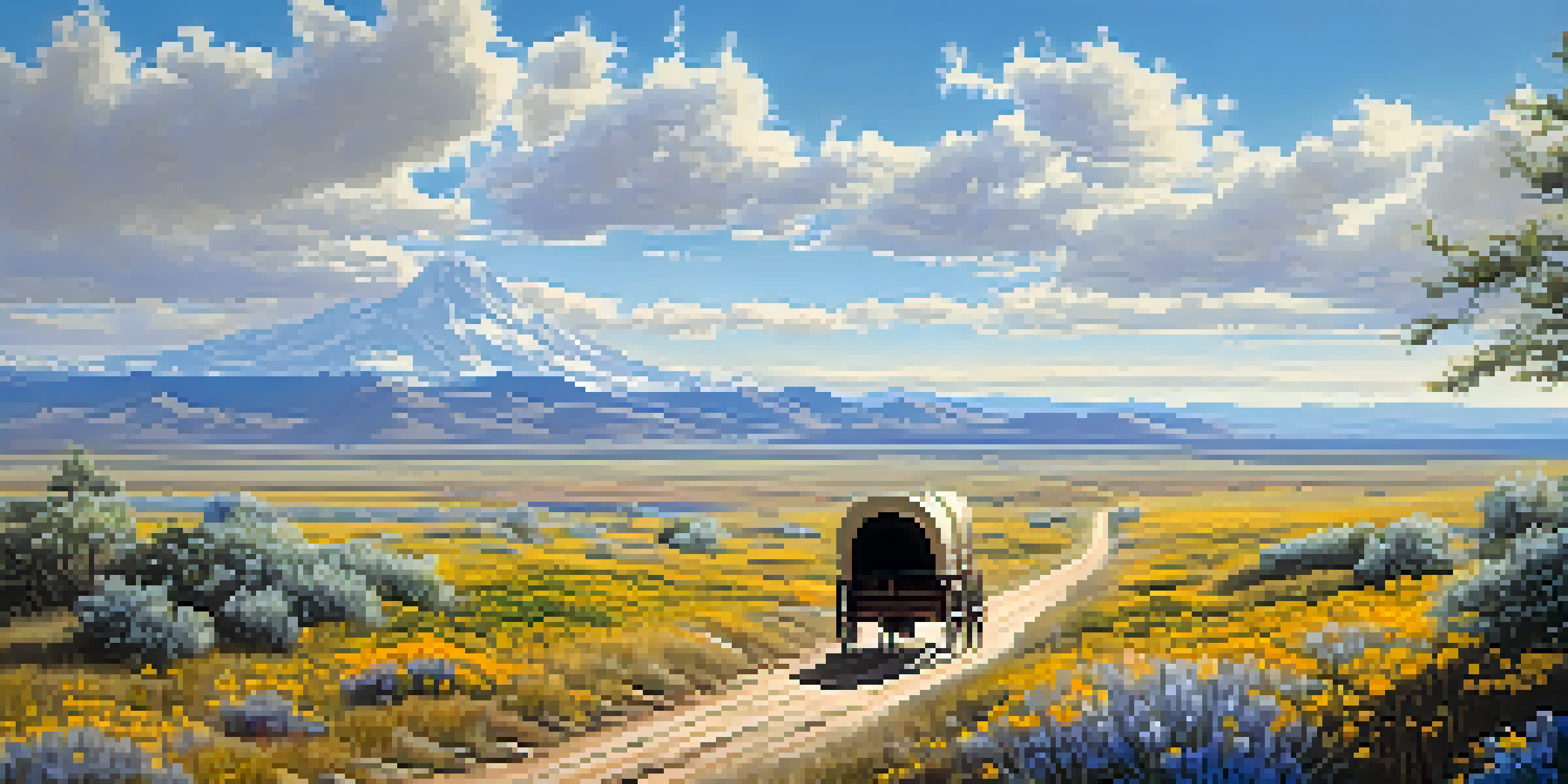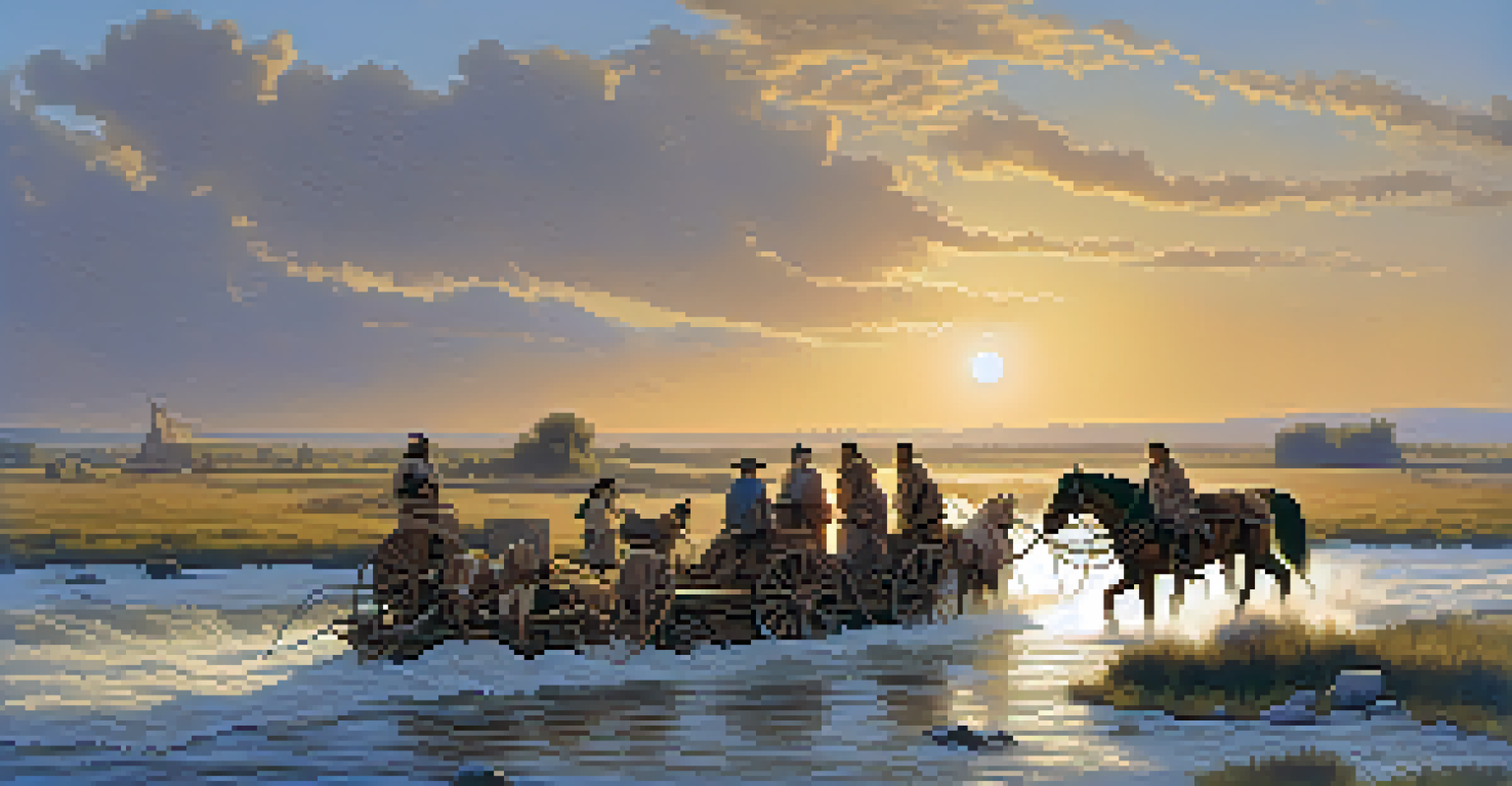The Historic Trail of the Oregon Trail: A Pioneer Experience

The Origins of the Oregon Trail: A Path to Opportunity
The Oregon Trail was born out of the American spirit of exploration. It emerged in the early 1840s as settlers sought new opportunities in the fertile lands of the West. This trail stretched over 2,170 miles, connecting Missouri to the Willamette Valley in Oregon, and was a beacon of hope for many families facing hardship.
The Oregon Trail was the great highway of the pioneers, a chance to seek a new life in a new land.
Many pioneers were motivated by the promise of land and prosperity. They faced daunting challenges, including harsh weather, rugged terrain, and limited supplies. Yet, the allure of a better life pushed them forward, forging a path that would change the course of American history.
This historic route not only represented a physical journey but also a quest for a fresh start. Each wagon train that set out was filled with stories of dreams, struggles, and the indomitable human spirit, making the Oregon Trail a symbol of resilience.
Preparing for the Journey: Pioneers' Essential Supplies
Preparing for the Oregon Trail expedition required careful planning and resourcefulness. Pioneers stocked their covered wagons with essential supplies, such as food, clothing, tools, and medical kits. The goal was to ensure they could sustain themselves through the months-long journey, which was no small feat.

Families often had to make difficult choices about what to bring, weighing the importance of each item against the limited space in their wagons. They relied on lists and advice from those who had traveled before them, knowing that every decision could impact their survival.
Pioneers' Resilience on the Trail
Despite facing numerous challenges, pioneers demonstrated extraordinary resilience as they navigated the hardships of the Oregon Trail.
Interestingly, many pioneers also carried sentimental items—a family Bible, a cherished quilt, or photographs. These items served as reminders of home and provided comfort during the long, arduous trek across the plains.
Life on the Trail: Daily Struggles and Triumphs
Life on the Oregon Trail was a mix of daily struggles and unexpected triumphs. Pioneers often rose with the sun, embarking on long days of travel, which could stretch up to 15 miles. They faced numerous obstacles, including rivers to cross, mountains to climb, and the ever-present threat of illness.
To be a pioneer is to live a life of adventure and challenge, seeking the promise of a better future.
Despite the hardships, there were moments of joy along the way, such as finding a meadow full of wildflowers or an unexpected stream for refreshing water. These small victories helped lift spirits and fostered a sense of camaraderie among the wagon trains.
As families shared stories around the campfire at night, they built bonds that would last a lifetime. The shared experience of navigating the challenges of the trail created a unique sense of community that defined the pioneer journey.
Encounters with Native American Tribes
As pioneers traveled the Oregon Trail, they often encountered Native American tribes, each with their own rich cultures and histories. These interactions varied widely; some were friendly and cooperative, while others were marked by conflict and misunderstanding. Pioneers relied on Native Americans for guidance, supplies, and knowledge of the land.
Many tribes, including the Sioux and Nez Perce, were initially curious about the settlers and offered assistance. They shared vital survival skills, such as hunting techniques and edible plants, which greatly aided the pioneers during their journey.
Cultural Interactions with Tribes
Encounters with Native American tribes varied from cooperation to conflict, significantly impacting the pioneers' journey and the tribes' way of life.
However, the influx of settlers ultimately led to significant changes in the Native Americans' way of life. The growing number of wagons and encroaching settlers caused tensions that would have lasting effects on the relationships between the two groups.
Challenges Faced: Weather, Terrain, and Health
Pioneers faced an array of challenges while traversing the Oregon Trail, with weather and terrain being two of the most formidable foes. The trail passed through scorching deserts, raging rivers, and treacherous mountain passes, each presenting unique hazards. Pioneers had to adapt quickly to changing conditions to ensure their survival.
Health issues were also a constant concern on the trail. Diseases like cholera and dysentery, coupled with injuries from accidents, took a toll on wagon trains. Pioneers often had to rely on their basic medical knowledge and whatever supplies they had brought along.
Despite these challenges, the resilience of the human spirit shone through. Pioneers banded together to help one another, creating communities that offered support in times of crisis, illustrating the power of unity in overcoming adversity.
The Legacy of the Oregon Trail in American History
The Oregon Trail has left an indelible mark on American history, representing not just migration but also the pursuit of dreams and opportunities. It played a crucial role in the westward expansion of the United States during the 19th century, contributing to the concept of Manifest Destiny—the belief that Americans were destined to expand across the continent.
Today, remnants of the trail can still be seen, from ruts in the earth to historic landmarks that tell the stories of those who traveled it. The Oregon Trail has become a symbol of adventure and determination, inspiring countless books, films, and educational programs.
Legacy of Westward Expansion
The Oregon Trail symbolizes the pursuit of opportunity in American history, highlighting both the spirit of exploration and the complexities of its impact on Native peoples.
As we reflect on the legacy of the Oregon Trail, it's essential to recognize the complexities of this journey. While it showcases the pioneering spirit, it also reminds us of the impacts on Native peoples and the environment, urging us to learn from history as we move forward.
Modern-Day Oregon Trail: Exploring History and Heritage
Today, the Oregon Trail is not just a historical route; it's a journey to be experienced. Numerous organizations and parks work tirelessly to preserve the trail's history, offering interactive exhibits and educational programs that bring the pioneer experience to life. Visitors can walk in the footsteps of those early settlers and gain a deeper understanding of their struggles and triumphs.
Traveling along the Oregon Trail today, you can visit historic sites like Chimney Rock and the Oregon Trail Center, which offer a glimpse into the past. These locations provide a unique opportunity to learn about the daily lives of pioneers, featuring reenactments, artifacts, and engaging storytelling.

By exploring the modern remnants of the Oregon Trail, we not only honor the legacy of those who ventured westward but also inspire future generations to appreciate the spirit of exploration and the importance of understanding our shared history.